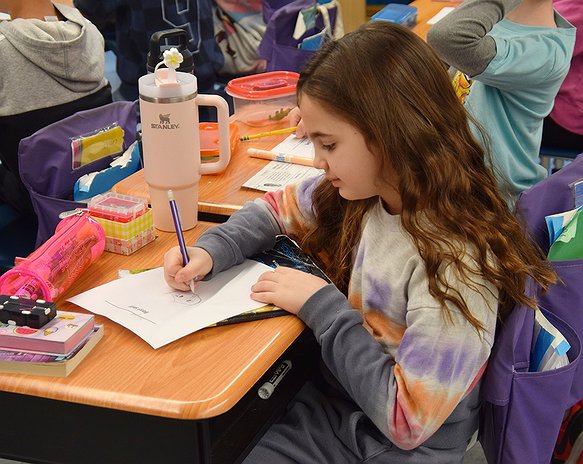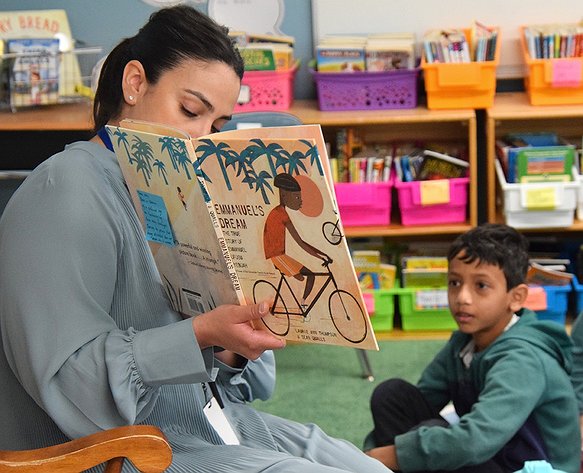Yale RULER program helps students develop emotional intelligence at B.B.
February 29, 2024 at 12:19 a.m.
Over the past several years, the Blind Brook School District has intensified its emphasis on incorporating Social-Emotional Learning (SEL) in its curriculum.
After several years of delay, this school year finally saw the rollout of one of the district’s newer programs—an initiative designed to help students understand their feelings, build emotional intelligence and create a positive expressive environment in classrooms.
Blind Brook Superintendent of Schools Dr. Colin Byrne said the initiative, the Yale RULER program, was adopted to help provide students with tools that can assist with their mental health.
“We’ve noticed, across the last several years, that students are struggling more,” he said. “There is more anxiety amongst younger children. And we recognize things are escalating for them and we need to give them every tool they need. Anything we can do to support them, we have to try to do.”
To that end, the district decided to introduce the Yale RULER program after seeing neighboring districts incorporate its practices and seeing Dr. Marc Brackett, the lead developer of the system, speak during an online workshop.
 Third-grader Kelly Gebrael draws a picture of her best self, an exercise encouraged through the Yale RULER program. The initiative is designed to help students become more emotionally intelligent by teaching them to properly identify complex emotions they’re experiencing and process them in a healthy manner.
Third-grader Kelly Gebrael draws a picture of her best self, an exercise encouraged through the Yale RULER program. The initiative is designed to help students become more emotionally intelligent by teaching them to properly identify complex emotions they’re experiencing and process them in a healthy manner.By David Tapia
“We were very impressed,” Byrne said. “And we decided it would be a good fit for us to have here.” Each building has started implementing the program in different ways. The elementary school sees a more direct approach through class instruction, while Blind Brook Middle/High School incorporates it into students’ advisory periods.
Developed by the Yale School of Medicine Child Study Center as a systemic approach to helping children from pre-kindergarten through the end of high school, the RULER acronym stands for:
*Recognizing emotions in oneself and others
*Understanding the causes and consequences of emotions
*Labeling emotions with a nuanced vocabulary
*Expressing emotions in accordance with cultural norms and social context
*Regulating emotions with helpful strategies
Byrne said administrators in the district were keen to add it to the curriculum.
Unfortunately, RULER’s implementation into the district was delayed by the COVID-19 pandemic and then the stalled construction at the elementary school.
Despite the setbacks, students at Ridge Street School are now being exposed to the program, according to Principal Tracy Taylor.
“We’ve done a very slow rollout,” she said. “Because you’re supposed to create a shared understanding with the entire faculty and staff before it gets to the kids.”
Adults in the building spent the last year learning about each part of the program from the 15 faculty members who underwent training with Yale University. To demonstrate how educators can use RULER as they teach, the newest school counselor has been entering classrooms for short periods of time each week.
That counselor, Katarina Pumarejo, is the “model” of the program, according to Taylor.
“She’s showing how the conversation about emotions is supposed to go with students,” the principal said. “Through this, we’re indirectly giving the training to each teacher, because they’re in the room with her.”
“We’re all learning by doing,” Pumarejo said. “Just like kids learn.”
Pumarejo has been tasked with getting kids used to having discussions about emotions. “I’ve really just been rolling out the mood meter,” she said. “It’s one of the big tools of RULER and getting kids into the habit of having quick talks about how they’re feeling.”
The mood meter is a graph used to help students identify what emotion they are feeling.
“The x-axis is the degree of pleasantness, so the emotions on the left side are not pleasant and those on the right side are,” she explained. “The y-axis denotes the amount of energy someone is feeling.”
Sprinkled across the graph are 100 different emotions, ranging from despondent and apprehensive to exhilarated and serene.
Pumarejo explained it’s a tool that’s been helping children develop emotional intelligence.
“Showing the mood meter helps them identify more complex emotions,” she said. “Typically, if you ask kids how they’re feeling, they stick to the standard of angry, sad, happy and calm.”
When Pumarejo asked the third-grade students in Amy Blumstein’s class to describe what emotions they were experiencing on the morning of Wednesday, Feb. 28, they turned their heads towards the graph.
Some said they were feeling restful or relaxed. Another let his teacher know he was anxious because of an upcoming doctor’s appointment that was scheduled to feature a needle.
From there, Pumarejo requested students read the details of their classroom charter—another tool that is key to RULER.
“The charter is a promise of how students want to feel in a classroom and what behaviors will help achieve those emotions,” she explained, noting no two charters are the same, every student and adult in the room is a part of the development. “We revisit the charter every few lessons, just to make sure they’re sticking to their agreement and to give examples of how they’re sticking to it,” she added.
In Blumstein’s class, the group decided they wanted to feel happy, calm and peaceful while together. To achieve that status, the students agreed they would cheer each other up when needed, greet each other every day and more. When Pumarejo asked if they had been working towards creating that environment, the third-graders unanimously came together to report they had.
It’s clear the students in the classroom have become more comfortable discussing complex emotions with Pumarejo, as they moved from chatting about the feelings of characters in a book to how they described themselves. The language they used matched that found on the mood meter, which is the main goal of the program.
“The way we can gauge the success of RULER at the elementary level is mostly anecdotal,” Byrne said. “But we’ve started seeing students use the RULER program language. They don’t just say they’re upset, but they’re using the tools they’ve been given to express themselves in an in-depth way.”
If a student finds themselves feeling an unpleasant emotion, Pumarejo helps them work through it by regulating it. “We encourage students to pause and breathe before responding or think of their best self,” she said. “It’s part of the goal of SEL in general. We have to be able to help children unpack and navigate their emotions.”
RULER is still in the process of reaching every grade level at Ridge Street School. “I’ve been working my way through each grade,” Pumarejo said. “I still have to get to the fourth and fifth-graders.”
As the teachers become more accustomed to the tools and goals of the program, Taylor is hopeful it will spread to all faculty. “Everybody has to be talking the same talk,” she said. “The hope is that the children will be able to go up to any adult and be able to have a conversation using the RULER language.”
“The ultimate goal is to have the mood meter and RULER everywhere,” Taylor said. “But we have to be mindful that there is a learning curve for everyone. Not just the kids but the teachers who are doing this for the first time as well.”





Comments:
You must login to comment.